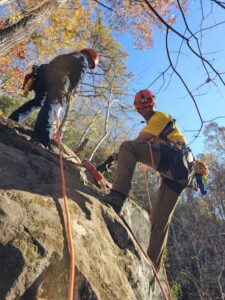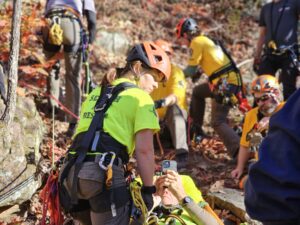When the Great Smoky Mountains National Park Search and Rescue Team reached out to Elevated Safety, the request for wilderness rescue training was very specifically intended to get down to the basics and keep the methods simple and repeatable. A key point to remember is that the GSMNP SAR responders have busy jobs keeping the most visited National Park in the US running smoothly with over 12 million visitors annually and a response area covering over 522,000 acres. Having a dedicated staff comprised of Emergency Management, Law Enforcement, Back Country Rangers, Wildlife Management, Medical Staff, Administration, BUSAR, and mutual aid of neighboring fire departments all contributing to the Technical Rescue program means that consistency and simplicity of equipment and technique is paramount to their operational efficiency.

Though ES has traditionally been very urban based, with the recent addition of Peak Rescue and the number of ES staff who also perform mountain/wilderness SAR, we work very comfortably in both urban/industrial and backcountry/wilderness environments.
Wilderness rescue is not gear heavy, it’s not sexy, it often requires very little rope work, and it’s hardly ever truly vertical. What’s the biggest hazard we face on rope while on low/ steep/ high angle? Industrial rescue folks will immediately start talking about hazards like fall factors and the need for edge pro. Here, the #1 concern is ground bees and snakes. That mindset of having a heightened awareness of environmental factors in the backcountry is different than those needed in most man-made, urban environments.
 We covered patient access, systems overview, patient packaging and mobility, multipoint anchoring, rope and personal mobility, operational risk assessment, edge transitions, communication, and roadside response. All with an emphasis on simplicity and efficiency in remote locations. Our consensus goal was hands-on repetition, individual confidence in gear selection, equipment application and limitations, and team-based consistency. The team performed with excitement, positivity and comradery. What more can you ask for?!
We covered patient access, systems overview, patient packaging and mobility, multipoint anchoring, rope and personal mobility, operational risk assessment, edge transitions, communication, and roadside response. All with an emphasis on simplicity and efficiency in remote locations. Our consensus goal was hands-on repetition, individual confidence in gear selection, equipment application and limitations, and team-based consistency. The team performed with excitement, positivity and comradery. What more can you ask for?!
It did help that all three ES instructors were also SAR members used to working in similar steep, wet, thick terrain with our highest call volume being Motor Vehicle Accidents over the bank. Our response area being mainly Blue Ridge Parkway, gave us common ground with this team.
The team there was appreciative of our efforts to provide realistic, simple and concept-based training. We can’t say enough good things about the dedication and level of care these responders give to the visitors of the park they manage!

